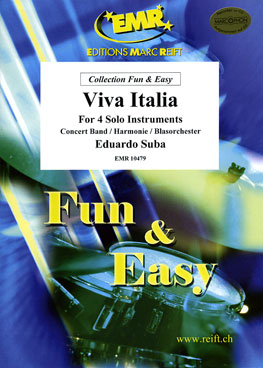Results
-
£117.80
Ballad For Flute and Wind Band - Carl Reinecke
Estimated dispatch 7-14 working days
-
 £76.80
£76.80 -
 £117.20
£117.20 -
£86.40
Fiesta for Flute - Wim Laseroms
Estimated dispatch 7-14 working days
-
£165.60
Concerto In D Major For Flute and Wind Band - Carl Reinecke
Estimated dispatch 7-14 working days
-
 £84.99
£84.99Flutes Forever (Concert Band - Score and Parts)
As the title implies this new piece brings the flute section into the limelight. Following a fast introduction by the accompanying band, the flute section follows in three-parts with a rapidly syncopated/staccato theme. After a short interlude by the band, this opening theme appears once again. The second flute theme returns following a short passage in which the band and the soloists alternate and the piece comes to a entertaining conclusion. Let your flute section shine with this playful new work. 03:00
Estimated dispatch 7-14 working days
-
 £116.10
£116.10VIVA ITALIA (Flexible Quartet with Easy Concert Band) - Suba, Eduardo
Quartet instrumentation: Part 1 - Flute, Clarinet, Alto Sax or Trumpet; Part 2 - Flute, Clarinet, Alto Sax or Trumpet; Part 3 - Flute, Clarinet, Alto Sax or Trumpet; Part 4 - Flute, Clarinet, Alto Sax, Tenor Sax or Trumpet. Duration: 4:20
Estimated dispatch 7-14 working days
-
 £84.99
£84.99Flutes Forever - Wim Laseroms
As the title implies this new piece brings the flute section into the limelight. Following a fast introduction by the accompanying band, the flute section follows in three-parts with a rapidly syncopated/staccato theme. After a short interlude by the band, this opening theme appears once again. The second flute theme returns following a short passage in which the band and the soloists alternate and the piece comes to a entertaining conclusion. Let your flute section shine with this playful new work.
Estimated dispatch 7-14 working days
-
 £21.50
£21.50Washington's Fanfare - Alexander N. Abbott
Abbott's new flute choir rings true to the best of the presidential fanfares, an original work which evokes the pageantry and honor of its subject. Score and parts are supplied for piccolo, 3 flutes, alto flute, bass flute, contrabass flute, and string bass, with many substitution options.
Estimated dispatch 7-14 working days
-
 £32.95
£32.95Sinfonia From Cantata No.29 - Johann Sebastian Bach
Traditionally performed by solo organ, Bach's Sinfonia from Cantata No. 29 is arranged here for flute choir, with the piccolo parts closely following how an organist would perform the music. This arrangement has interesting textural and dynamic contrast, despite few dynamic markings, which Long creates through thoughtful scoring of different flute parts playing in various registers of the flute range. This arrangement was premiered in July of 2009 by the New England Conservatory Summer Metropolitan Flute Festival Orchestra in the New England Conservatory's renowned Jordan Hall. For advanced players.
Estimated dispatch 7-14 working days
